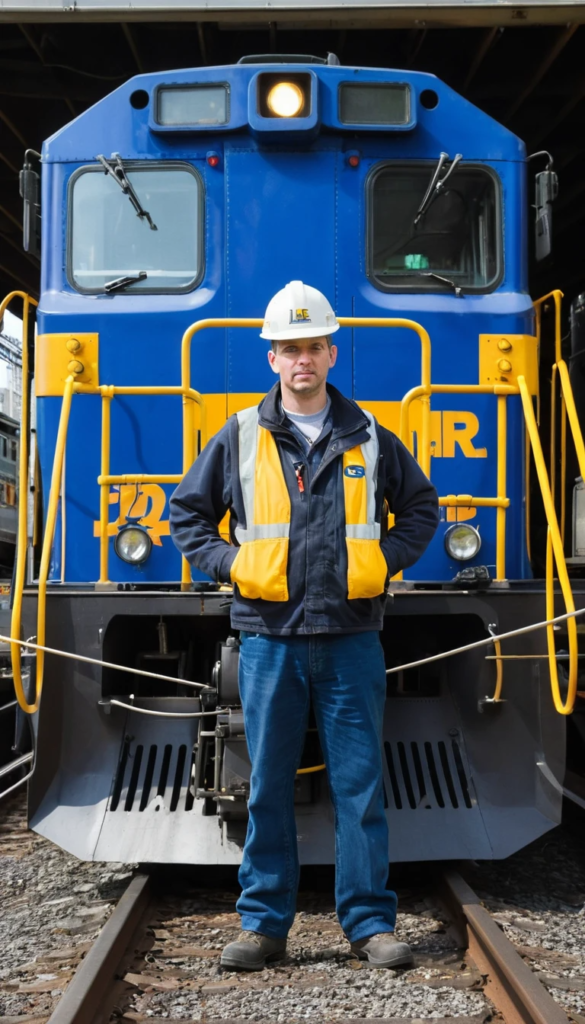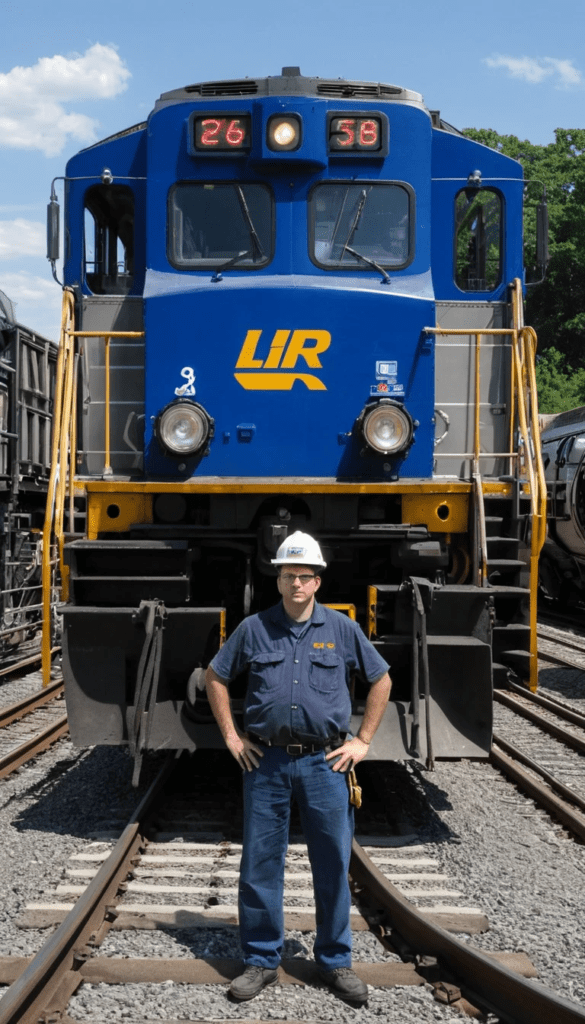LIRR Locomotive Engineer – Long Island Rail Road (LIRR) has a healthy mix of locomotives and railcars in its fleet to provide commuter transport service across Long Island and New York City. The LIRR mostly operates dual-mode locomotives and diesel-electric locomotives that can use both electrified and non-electrified tracks. These locomotives are built for high passenger volumes but also for reliability, fuel efficiency, and environmental sustainability.

Moreover, LIRR locomotive engineers are put through intense training programs that prepare them to handle complicated rail systems and make sure that the safety of the passengers is maintained in every situation. Part of the railroad’s modernization plans is the replacement of the current fleet with brand new M9 electric train sets, track infrastructure upgrades, and the use of digital monitoring and predictive maintenance systems for operational efficiency.
Types of LIRR Locomotives Engineer
LIRR runs dual-mode locomotives, which allow them to run on either diesel or electric, making them capable of traversing electrified and non-electrified tracks without needing to change trains.
| Locomotive Model | Type | Power Source | Usage |
|---|---|---|---|
| EMD DE30AC | Diesel-Electric | Diesel-generated electricity | Used on non-electrified routes |
| EMD DM30AC | Dual-Mode | Diesel & Third-Rail Electric | Used for direct service to Penn Station |
| BL20GH | Diesel-Electric | Diesel-generated electricity | Used for work trains and yard operations |
The LIRR fleet features the following primary locomotives:
- EMD DE30AC – A diesel-electric locomotive for non-electrified routes. It is widely used for long-distance travel across Long Island.
- EMD DM30AC – A dual-mode locomotive that can operate with diesel power in non-electrified regions or third-rail electric power in electrified areas and run directly into Penn Station without changing engines.
- BL20GH — A smaller diesel-electric locomotive also used occasionally for yard operations and work trains.
What does an LIRR Locomotive Engineer do?
A LIRR Locomotive engineer runs the train and ensures that it runs safely and on time. They operate controls in the train cab, follow the signals, stop at stations, and see the track further. They check the train before the trips, monitor the speed range, and communicate with conductors and dispatchers to stay updated about tracks and signals. If there is bad weather or an emergency, they carefully handle the train to keep the passengers and the crew safe. In simple words, an LIRR locomotive engineer is like the main driver of the train, ensuring that everyone finds the place where they need to go safely.
LIRR Locomotive Engineer Trainee
- Role: A certified locomotive engineer learns to operate LIRR trains under supervision before becoming an engineer.
- Training: Class lessons, simulators, and on-the-job training along with experienced engineers.
- Salary: The average early salary for trainees is around $ 25– $ 30 per hour, growing after certification (full engineers can earn $ 80,000– $ 100,000+ per year, based on seniority and overtime).
- Work hours: shift work – including night, weekend, holidays; Should be flexible.
- Benefits: Good Union Benefits, Health Insurance, Retirement Scheme, Payment Holiday.
- Requirements: Written test, physical examination, medical screening, and background check should be passed.
- Skill requirement: good attention, ability to follow safety rules, strong communication, readiness for long innings.
- Development: After training and certification, they become full locomotive engineers with a high salary and seniority.
- Union: Transport labor is usually represented by the Union (eg, BLE & T or so etc.).
- Job Outlook: Stable, because rail operations require skilled engineers for safe passenger service.
Minimum Requirements
- Age: Usually should be at least 21 years old.
- Education: A High school diploma or GED is required.
- Work Eligibility: U.S., must be legally authorized to work in
- Driver’s License: A valid driver’s license is usually necessary.
- Background check: A criminal background check should be passed.
- Medical Examination: A physical examination, vision and h, and hearing test should be passed.
- Drug Tests: Drug and alcohol screening should be passed.
- Skills: Good reading, mathematics, and communication skills.
- Schedule Flexibility: Night, weekend, holidays and o, and overtime should be ready to work.
- Training Commitment: Classes should be ready to complete and training on the job, passing all necessary tests, and working safely under supervision.
How LIRR Locomotives Work
LIRR’s diesel-electric locomotives operate the same way, generating electricity using diesel engines that power electric traction motors that turn the wheels. It gives it a nice balance of fuel economy with power and performance. In contrast, dual-mode locomotives can switch from diesel-electric to third-rail electric, making them ideally suited for routes that go from non-electrified territory into New York City’s electrified rail network.
[ Train Departs from Non-Electrified Area ]
↓
[ Diesel Engine Generates Electricity ]
↓
[ Electricity Powers Traction Motors ]
↓
[ Train Moves on Diesel Mode ]
↓
[ Train Reaches Electrified Zone ]
↓
[ Switches to Third-Rail Electric Power ]
↓
[ Train Continues on Electric Mode ]
↓
[ Arrives at New York Penn Station ]
Benefits of LIRR Locomotive Technology
| Feature | Description |
|---|---|
| Seamless Travel | Dual-mode locomotives allow direct service between non-electrified areas and NYC without switching trains. |
| Fuel Efficiency | Diesel-electric technology balances power and fuel consumption, making long-distance travel efficient. |
| Environmental Benefits | Electric mode reduces emissions and noise pollution in urban areas. |
| High Performance | LIRR locomotives are built to handle heavy passenger loads and peak-hour service demands. |
- Seamless Travel – Dual-mode locomotives avoid transfers between diesel and electric trains, enabling passengers to travel right from non-electrified territory to Manhattan.
- Fuel Efficiency – Long-distance travel optimization of diesel-electric locomotives helps balance power and fuel consumption.
- Environmental — LIRR is powered by electric power in urban routes, lessening emissions and noise pollution and improving the air in New York City.
- High Performance – Designed to transport heavy passenger loads, the locomotives provide dependable service during peak hours.
Future of LIRR Locomotives
LIRR is also assessing the use of contemporary, more efficient locomotives to reduce environmental impact and improve efficiency, including hybrid and battery-powered trains. The new locomotive designs will also deliver enhanced fuel economy, improved acceleration, and increased passenger comfort.
As such, LIRR’s fleet of locomotives has been essential in tying Long Island and New York City together, and a mix of diesel, electric, and dual-mode locomotives has helped to ensure rapid and dependable train service. As technology continually evolves and develops, so will these sustainable, high-performing locomotives, with the LIRR reaping the benefits of these advancements with every new-generation locomotive that is delivered in the coming years.
- Hybrid locomotives with battery-assisted power.
- Fully electric trains for improved sustainability.
- AI-driven safety and automation technologies to enhance operational efficiency.
How to Become a Locomotive Engineer at LIRR
Becoming a Locomotive Engineer at LIRR requires training, certification, and hands-on experience. Below is a step-by-step guide on how to enter this profession.
Step 1: Meet the Basic Requirements
- Must be at least 21 years of age.
- Must possess a high school diploma or GED.
- Possession of a valid driver’s license e required.
- Able to pass a background check and drug screen.
Step 2: Gain Railroad Experience
- Most engineers begin their careers as conductors or in other entry-level railroad occupations.
- Experience with railroad safety, signaling, and train operations is useful.
Step 3: Apply for LIRR’s Engineer Training Program
- LIRR has programs to train a new generation of locomotive engineers.
- Candidates submit to written tests, mechanical exams, and physical assessments.
- Training consists of classroom work, simulator exercises, and operation of the locomotive.
Step 4: Obtain Federal Railroad Administration (FRA) Certification
Locomotive engineers must pass the FRA certification exam, which includes:
- Safety protocols and operational regulations
- Train Complements & Mechanical Systems
- Emergency procedures
Step 5: Complete On-the-Job Training (OJT)
- Engineers get on-track training on a supervised basis with experienced instructors. Familiarize yourself with route navigation, interpret signals, and learn emergency procedures.
Step 6: Pass the Final Qualification Tests
- Engineers have to show proficiency in locomotive operations.
- The final evaluations would include performance tests and FRA compliance checks.
Step 7: Start Working as a Certified Locomotive Engineer
- When trained and certified, engineers operate LIRR trains throughout the network.
- Further training and intermittent FRA recertification are necessary.
LIRR Locomotive Engineer Salary
Locomotive Engineer salary progression at the Long Island Rail Road (LIRR) is determined by date of hire. A detailed breakdown is provided below:
For Employees Hired On or Before February 26, 2015:
| Stage | Percentage of Full Rate | Hourly Rate | Duration |
|---|---|---|---|
| Until Qualification | 70% | $34.94 | Until qualified |
| Upon Qualification | 100% | $49.92 | Thereafter |
For Employees Hired After February 26, 2015:
| Year of Service | Percentage of Full Rate | Hourly Rate | Duration |
|---|---|---|---|
| 1st 365 days | 60% | $29.95 | 1 year |
| 2nd 365 days | 80% | $39.93 | 1 year |
| 3rd 365 days | 90% | $44.93 | 1 year |
| After 1,095 days | 100% | $49.92 | Thereafter |
Full engineers on unlimited types will also earn a $10.00 Certification Allowance per tour of duty.
1. What does a LIRR Locomotive Engineer do?
A LIRR Train Design works trains, guaranteeing secure and convenient transport of travelers along the Long Island Rail Road framework.
2. How do you become a LIRR Locomotive Engineer?
To gotten to be a LIRRBuildern Build, complete training, including written and hands-on exams, and meet government certification standards.
3. What is the average salary of a LIRR Locomotive Engineer?
LIRR Train Engineers can get a normal compensation ranging from $90,000 to over $130,000 yearly, dependexperiencelvemenovertimeinutes.
4. What qualifications are needed to apply for the role?
Candidates ordinarily require a high school diploma or GED, substantial driving experience, solid mechanical skills, and musthe physicalapeubackgroundundation checks.
5. Is the job of a LIRR Locomotive Engineer physically demanding?
Yes, the part can be physically and rapidly demanding, requiring long hours, part shifts, center, and the capacity to respond rapidly in crises.
6. Is being a Locomotive Engineer at the LIRR a union job?
Yes. Locomotive Engineers are represented by the Brotherhood of Locomotive Engineers and Trainmen (BLET), which negotiates wages, benefits, and working conditions.

